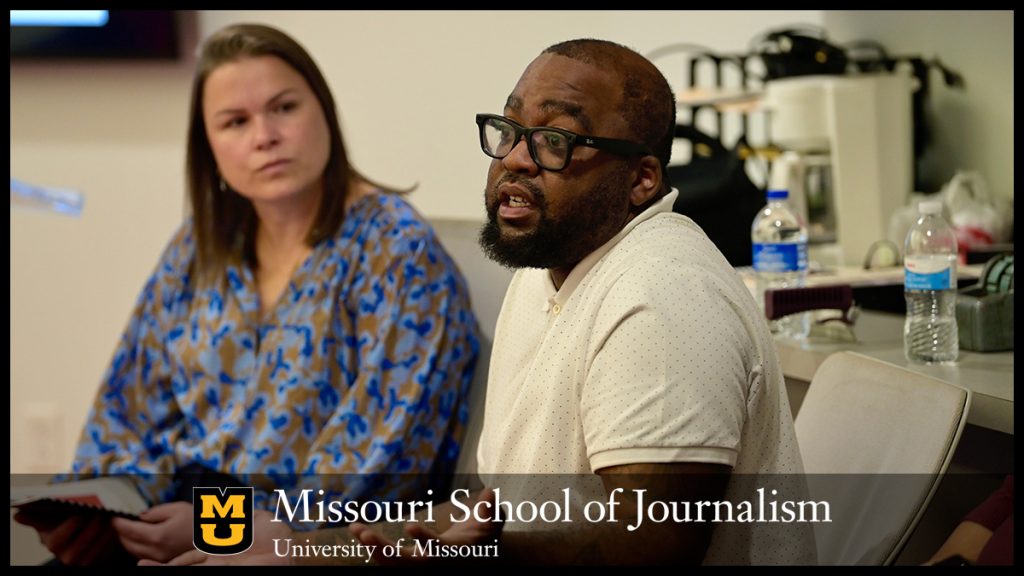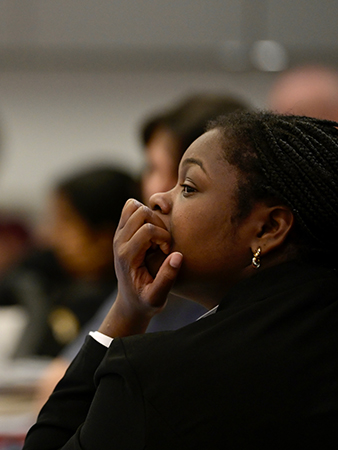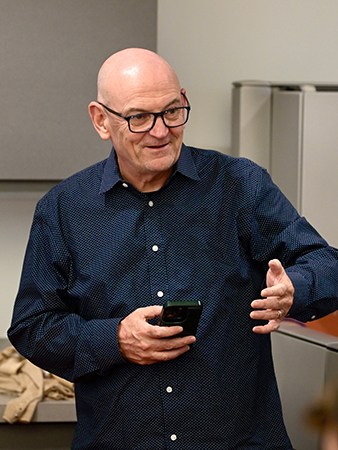Documentary seeks to heal rift between public and news industry with trauma-informed approach to gun violence

Jessica Beard and Oronde McClain
“The Second Trauma” hopes to bring an end to sensationalized, episodic coverage of America’s signature brand of violent crime
By Austin Fitzgerald
Photos by Nate Brown
This week, a panel of educators, journalists and experts in public health and trauma visited the Missouri School of Journalism to present “The Second Trauma,” their documentary about the ways in which news coverage of gun violence can negatively impact victims and their families.
The panel, led by former Reynolds Journalism Institute (RJI) Fellow and Philadelphia Center for Gun Violence Reporting (PCGVR) Director Jim MacMillan, brought the short film to a variety of classes at the School of Journalism over a period of two days, from senior and graduate-level courses to freshman seminars. The goal was to spark a conversation about how the industry can avoid perpetuating stereotypes and amplifying trauma when reporting on violent crime.
“I’ve been a reporter for a really long time, and the really sad truth is it doesn’t matter if you’re covering fashion or futures. You could find trauma knocking at your door,” said Yvonne Latty, a professor at Temple University and director of the Logan Center for Urban Investigative Reporting, while introducing the week’s first presentation in the RJI Futures Lab.
The film that followed lived up to that idea, centering the stories of lives ended and upended by the sudden shock of gun violence. Victims and family members recounted how candid crime scene footage, inaccurate facts and narratives that excluded their voices contributed to a “second trauma” that compounded their pain.
“It’s important for journalists to understand that the way we cover stories has ripple effects — that superficial storytelling can have impacts that are far from superficial,” said Randy Picht, executive director of RJI, where MacMillan was working as an RJI Fellow when he received the $50,000 grant that helped launch PCGVR. “Whether you’re a student or a seasoned reporter, you can benefit from the views shared in this documentary.”
On the panel, Latty and MacMillan were joined by Jessica Beard, a trauma surgeon and the director of research at PCGVR, and Oronde McClain, PCGVR’s credible messenger newsroom liaison and the survivor of a gunshot to the head that he sustained at the age of 10. Each brought their own personal and professional perspectives to the film and the subsequent discussions with students, discussions that did not shy away from broaching difficult topics.
“I was taken aback initially,” said one student reacting to the film’s criticism of quick-turnaround stories about gun violence. “I felt I was being attacked for doing my job. I do understand that approaching someone months after the fact may be healthier for them, but it just goes against so much of what we’re taught to do.”
A central point of conversation that emerged was the difficulty of balancing two priorities: the need to avoid retraumatizing victims and the need to promptly inform the community, especially when the needs or preferences of victims and their families can vary. Beard argued that it’s time for the industry to approach gun violence through the trauma-informed lens that it applies to stories about suicide, which often include resources for audience members impacted by the topic and increasingly feature warnings for those who might find the content disturbing or traumatic.
“There is so much research that shows episodic crime reporting is harmful,” Beard said, referring to an approach to news that treats cases of gun violence as individual events rather than part of a larger trend or theme. “It’s harmful to our society, it reinforces racist stereotypes in the areas where it occurs and we know from research that people blame the victims.”
The alternative, Beard added, is to frame gun violence as preventable, not inevitable. It’s a shift in thinking that MacMillan said involves a number of complex factors, including generational differences in newsrooms and a cultural divide that can emerge between journalists and the communities they cover.
“There is a small number, maybe 20 percent, who say, ‘I’ve been looking for this for so long — how do I get involved?” said MacMillan, for whom the road to establishing PCGVR began with his RJI Fellowship in 2019. “Most of the people say, ‘It’s complicated, we’re not sure.’ Then there’s a slice that says, ‘Jim, we observe and report, people don’t understand what we do.’”
The team is actively working to close that “understanding gap.” McClain is conducting trainings through Survivor Connection, which prepares gun violence survivors to speak with media in ways that protect their own well-being while acknowledging the role of journalists in elevating their voices. Beard is performing research underlining the lopsided use of police sources rather than the perspectives of survivors in stories about violent crime, and Latty and MacMillan educate students at Temple University about trauma-informed reporting.
In addition, PCGVR has produced a free toolkit with practical examples of how journalists can replace harmful or stigmatizing narratives with ones that humanize the subjects and quote alternative sources, such as public health experts.
“People think journalists don’t care because they only come to the community when blood is shed,” McClain said, noting that before he learned more about how the news industry works, he blamed reporters for the way his story was told. “They think you’re worse than the cops, and that’s a bad thing. I want to try to bridge that gap.”
McClain noted that one way for journalists to improve their community relationships is to pursue follow-up stories.
“There are lots of stories that end with saying, ‘the victim is in critical condition,’” he said. “I want to know next week or the week after: what happened?”
In the RJI Futures Lab, a space where students are taught to bring an innovative, tech-literate and forward-thinking approach to their work, Latty highlighted the role of students in changing the industry’s status quo.

“At my first job, a girl was killed by a serial killer, and I ended up breaking the news to her mother,” Latty said. “That was extreme. I had to focus on remembering why I was doing this. … The start of your career is when you’re most attached to the reasons why you’re doing journalism. Bring those with you to every single crime scene you go to.”
That sentiment struck a chord with Lynda Kraxberger, the School of Journalism’s associate dean for undergraduate studies, who reminded students that it sometimes takes some chutzpah to make the case in the newsroom for a follow-up versus a feel-good story about a community fish fry.
“It takes some agency to go up to an editor and say, even though this story might not seem important to our news coverage on this day, I am building connections and I’m making my presence known in the community,” Kraxberger said. “I’m telling people that I will be there for both good times and bad.”
For similar reasons, the group prefers to showcase “The Second Trauma” in person and strike up conversations at news organizations and higher education institutions rather than streaming it online. To learn more about the documentary and request a screening, click here.
Updated: October 17, 2024

